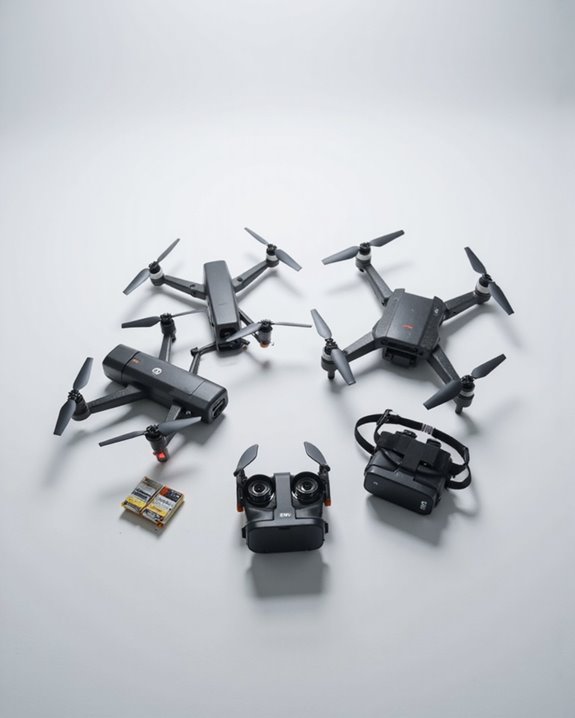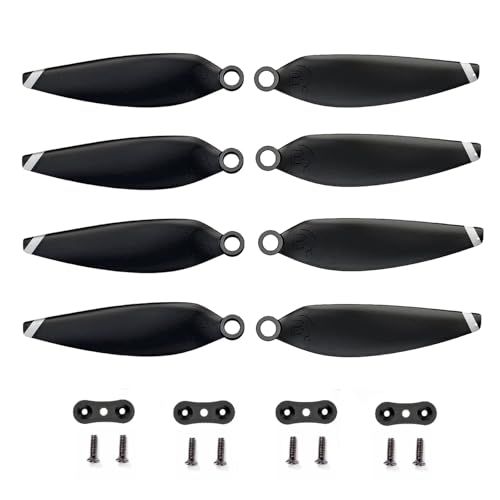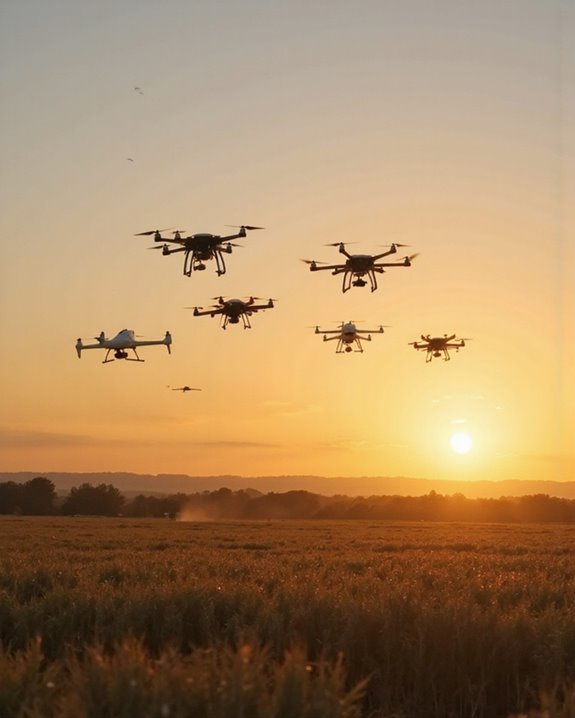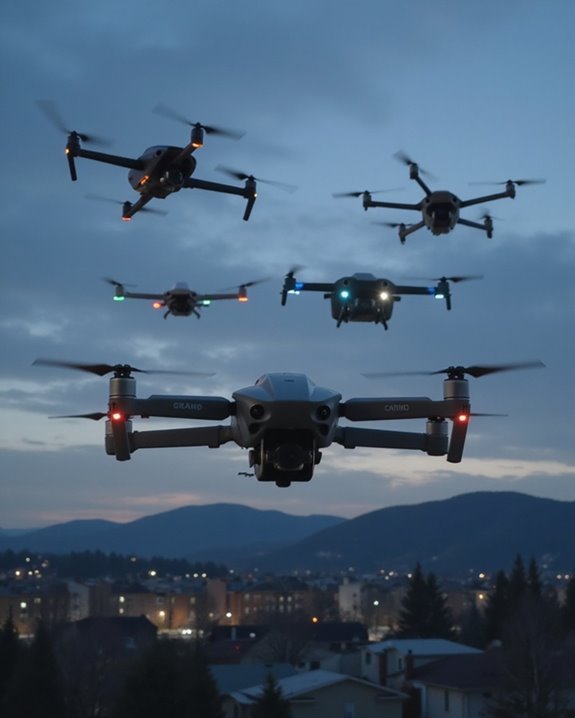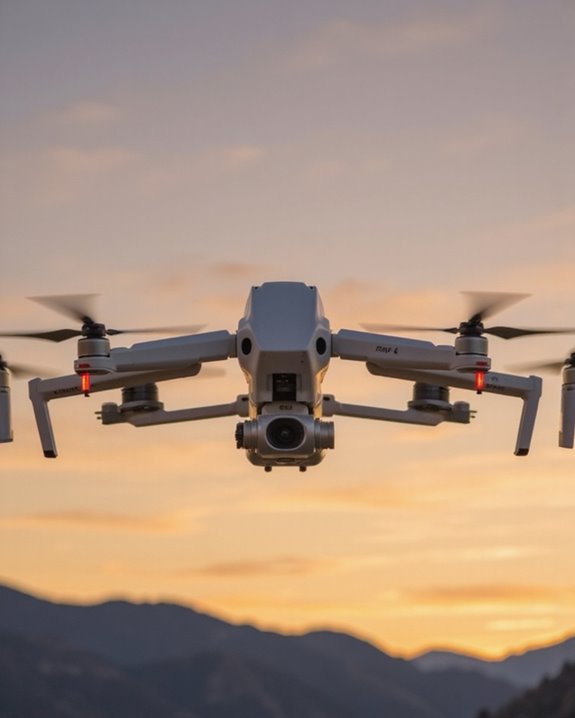Today’s top drone accessories pack serious punch! You’ll want the FAA-compliant Remote ID Module with its impressive 800m range, while the Quadrotor DIY Kit offers fantastic STEM learning opportunities. The HS175D propellers deliver smooth flights, and DYS’s 65A ESC brings racing-grade performance. Don’t forget DJI Mini 2’s orange replacement blades for that pop of style. Let’s explore how these cutting-edge parts can transform your aerial adventures in 2025!
Key Takeaways
- Remote ID modules with GPS tracking and 5.1-hour battery life are essential for compliance and safety in 2025.
- High-performance ESCs with 32-bit design and 2-8S lipo compatibility offer superior control for advanced drone builds.
- Dynamically balanced propellers improve flight efficiency and stability while remaining compatible across multiple popular drone models.
- DIY drone kits with optical flow positioning provide valuable STEM learning opportunities and customization options.
- Lightweight components that maintain proper weight distribution within 1-2% of ideal center gravity ensure optimal flight performance.
FAA Compliant Remote ID Module for Drones
- 🔥【𝐅𝐀𝐀 𝐑𝐞𝐠𝐮𝐥𝐚𝐭𝐢𝐨𝐧 𝐂𝐨𝐦𝐩𝐥𝐢𝐚𝐧𝐜𝐞】Veeniix Remote ID Module is suitable for a range of 4K camera...
- 🔥【𝐔𝐥𝐭𝐫𝐚-𝐂𝐨𝐦𝐩𝐚𝐜𝐭 𝐑𝐞𝐦𝐨𝐭𝐞 𝐈𝐃 𝐌𝐨𝐝𝐮𝐥𝐞】Veeniix Remote Identification Broadcast Module...
- 🔥【𝐔𝐥𝐭𝐫𝐚-𝐒𝐮𝐢𝐭𝐚𝐛𝐥𝐞 𝐟𝐨𝐫 𝐯𝐚𝐫𝐢𝐨𝐮𝐬 𝐭𝐲𝐩𝐞𝐬 𝐨𝐟...
Whether you’re a recreational pilot or professional drone operator, staying compliant with FAA regulations just got easier thanks to the Veeniix V113 Remote ID module! This lightweight powerhouse weighs just 13.49g and works with virtually every popular drone on the market, from DJI’s Mini series to professional Matrice models.
You’ll love the impressive 5.1-hour battery life and precise GPS tracking under 3 meters – no more worrying about losing sight of your drone! The plug-and-play design includes everything you need for installation: Velcro patches, zip ties, and a Type-C charging cable. With 4.6 stars from real pilots and a 90-day warranty, you can’t go wrong with this compact compliance solution.
Best For: Drone pilots of all experience levels who need to comply with FAA Remote ID requirements while flying DJI, custom-built, or other popular drone models.
Pros:
- Exceptional battery life of 5.1 hours and comprehensive compatibility with a wide range of drone models
- High-precision GPS tracking (under 3 meters) with real-time tracking up to 800m
- Complete installation kit included with multiple mounting options and responsive customer support
Cons:
- Relatively high price point compared to some competing Remote ID solutions
- Additional weight (13.49g) may impact flight time on smaller drones
- Limited user reviews (89 ratings) make long-term reliability difficult to assess
Quadrotor Drone DIY Kit for STEM Learning and Drone Basics
- Unique DIY Drone: This DIY drone integrates advanced optical flow positioning modules, video modules, and high-power brushless motors. You need to complete everything...
- An Impressive Project to Show Off: This project is packed with extensive basic knowledge of drones. It enables you to acquire more profound knowledge about drones during...
- Multi-functional Flight Experience: It offers five amazing flight functions: 360° roll, one-click takeoff and landing, headless mode, speed adjustment, optical flow...
Looking to explore into the fascinating world of drone building while learning valuable STEM skills? This thorough DIY quadrotor kit is perfect for aspiring drone enthusiasts aged 14 and up! You’ll spend about 1.5 hours assembling everything from scratch, including optical flow positioning modules, video components, and high-power brushless motors.
Once built, you’ll master exciting features like 360° rolls, one-click takeoff, and real-time video streaming. The sturdy frame, made from 3D-printed parts and carbon rods, can handle those inevitable learning curves – and yes, there are spare propellers included! While those tiny screws might test your patience, the detailed instruction manual and technical support will keep you soaring through this rewarding STEM adventure.
Best For: Teen and adult STEM enthusiasts looking for a challenging hands-on project to learn drone building fundamentals while developing technical skills.
Pros:
- Comprehensive educational value with detailed instructions and modifiable courseware
- Impressive flight capabilities including optical flow positioning and real-time video
- Durable construction with spare parts and strong technical support included
Cons:
- Assembly requires patience and precision with tiny screws
- 5-star difficulty level may be challenging for complete beginners
- Requires sustained focus and attention to detail during 1.5-hour build process
8Pcs HS175D Propellers for Drones, Replacement Blades
- Wide Compatibility: The propeller for HS175D F11MINI F7 MINI Q5 Q7 Q8 M7 WF31 HT50 drone, ensuring excellent flight performance and stability.
- High performance: The compact blade has undergone dynamic balancing to deliver powerful performance for the drone.
- Lightweight and portable: Made of lightweight materials, it reduces overall weight, improves flight efficiency, and is convenient to install.
Drone pilots seeking reliable replacement propellers will find excellent value in the 8Pcs HS175D Propeller set, which comes complete with all mounting hardware needed for a quick swap. You’ll appreciate how these lightweight blades are dynamically balanced to improve flight efficiency on popular models like the HS175D, F11MINI, and Q5 drones.
While customer ratings hover at 4.2 stars, you’ll want to exercise caution during installation – proper mounting is essential for stable flight! The package includes everything you need: 8 props, 8 screws, and 4 fixed covers. At just 0.317 ounces, these China-made replacements won’t weigh down your aircraft, and they’re a budget-friendly option for keeping your drone airborne.
Best For: Budget-conscious drone enthusiasts looking for affordable replacement propellers for their HS175D, F11MINI, and other compatible drone models who want a complete replacement kit with mounting hardware.
Pros:
- Complete kit includes 8 propellers, screws, and fixed covers for multiple replacements
- Lightweight design improves flight efficiency and performance
- Compatible with multiple popular drone models including HS175D, F11MINI, Q5, and others
Cons:
- Some users report propellers breaking during flight, raising safety concerns
- May cause flight instability if not properly installed
- Mixed reviews on durability and build quality
DYS Brushless ESC 65A 4in1 for FPV Drones (AM32)
- A 32-bit 4in1 Brushless ESC with AM32 firmware for FPV Freestyle Drone Racing Drone.
- ESC 65A 4in1 Supports 2-8S lipo input.
- The range of DYS ESCs adopt high-performance premium MOS, now Brushless ESC 65A 4in1 MOS is upgraded again with 15% performance improvement.
FPV racing enthusiasts and freestyle pilots will find their perfect match in the DYS Brushless ESC 65A 4in1, a powerhouse electronic speed controller that’s ready to handle the most demanding aerial maneuvers!
You’ll love how this 32-bit ESC supports an impressive 2-8S lipo input, giving you incredible voltage flexibility for your builds. The upgraded premium MOS delivers 15% better performance compared to previous models, and at just 27 grams, it won’t weigh down your quad. While the 3.4-star rating might raise an eyebrow, the ESC’s solid handling of freestyle quads and easy mounting on 30.5mm frames makes it a worthy contender for your next build. Just keep in mind there’s no 4v5 pad – but hey, nobody’s perfect!
Best For: Intermediate to advanced FPV drone pilots looking for a lightweight, powerful ESC for freestyle and racing builds that can handle high voltage setups.
Pros:
- Versatile voltage support ranging from 2S to 8S lipo batteries
- Lightweight design at just 27 grams makes it ideal for performance builds
- Premium MOS upgrade provides 15% performance improvement over previous models
Cons:
- Lacks 4v5 pads which may limit some configuration options
- Mixed customer reviews with an average 3.4/5 rating suggests potential reliability issues
- Some users report voltage handling problems that may affect performance
16Pcs DJI Mini 2 Propellers Replacement Blades (Orange)
- COMPATIBILITY: Please note that this propellers are only compatible with DJI Mini 2 / Mini SE / Mini 2 SE / Mini 4K Drone. (NOT for Mavic Mini! These are NOT original...
- LOW NOISE DESIGN: With lighter weight and low noise design, this propeller group will make your Mavic Mini drone fly more stable and quiet.
- MORE POWERFUL: The blade is small in shape, and after precise dynamic balance test, it provides strong power for drone and ensures longer endurance of drone.
These vibrant orange replacement propellers for the DJI Mini 2 are a must-have upgrade for pilots who want enhanced performance without breaking the bank! You’ll get 16 quick-release blades, perfectly compatible with Mini 2, Mini SE, Mini 2 SE, and Mini 4K drones.
The lightweight design delivers a quieter flight experience while maintaining strong power and endurance. Installation’s a breeze with the included mini screwdriver and screws, though you’ll want to add threadlocker for extra security. With precise dynamic balance testing and enhanced pitch, you’ll notice faster climbs and snappier descents – just remember to mark those blades correctly during setup!
Best For: DJI Mini drone pilots seeking cost-effective replacement propellers with enhanced performance and durability.
Pros:
- Includes comprehensive installation kit with 16 blades, screws, and screwdriver
- Delivers faster flight performance with improved climbing and descent capabilities
- Compatible with multiple DJI Mini models and some non-DJI drones
Cons:
- Requires careful blade marking during installation to ensure proper orientation
- Included screwdriver may not be ideal for assembly
- May need additional threadlocker for secure installation (not included)
Factors to Consider When Choosing Drone Parts
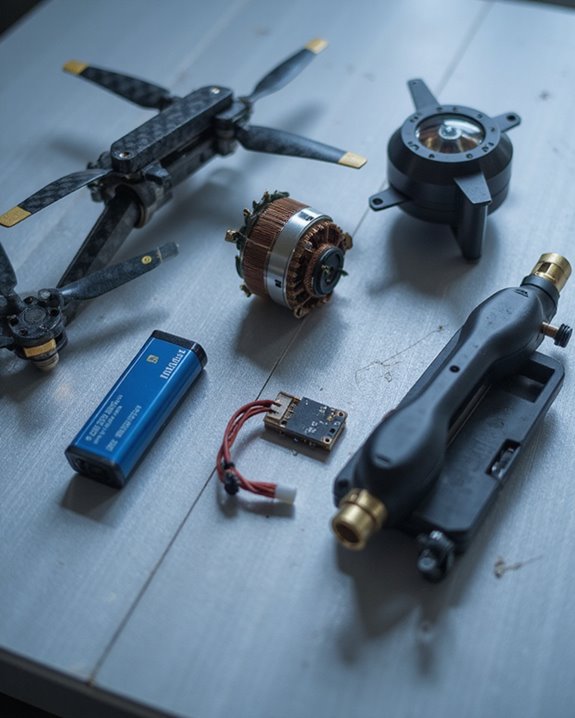
When upgrading your drone’s parts, you’ll need to carefully weigh several critical factors that can make or break your flying experience. You’ll want to check that new components maintain proper weight distribution and are fully compatible with your specific drone model, just like making sure puzzle pieces fit perfectly together! Beyond the basics, you’ll need to match power requirements and installation difficulty to your skill level while considering how each part – from propellers to cameras – will impact your drone’s overall flight performance.
Component Weight and Balance
Understanding how your drone’s weight and balance work together can make the difference between a smooth, efficient flier and a frustrating power-drainer! When you’re selecting components, remember that every gram counts – even small weight increases can slash your battery life by up to 20%.
You’ll want to distribute your parts evenly around the center of gravity, just like a tightrope walker with their balance pole. Lighter components made from advanced materials aren’t just about reducing weight – they’ll help your drone zip through turns like a hummingbird! Keep that center of gravity within 1-2% of the ideal point, or you’ll end up with a wobbly flier that vibrates like a washing machine. Trust me, proper weight distribution is the secret sauce that’ll keep your drone steady and responsive in the air.
Part Compatibility Assessment
Selecting compatible drone parts can feel like solving a complex puzzle, but don’t worry – we’ll break it down into manageable pieces! The key is knowing exactly what to check before making your purchase.
First, you’ll want to verify the physical specs – make sure your component fits within 3 meters for ideal tracking and won’t throw off your drone’s balance. Next, check those connectivity requirements (Bluetooth 4.0 or 5.0 compatibility is essential for seamless communication). Don’t forget about power needs – your parts should work with 2-8S lipo batteries and support up to 5.1 hours of flight time. Those mounting specifications matter too – a 30.5*30.5mm hole pattern isn’t just a random number! Finally, consider how each part affects your drone’s performance – because nobody wants a fancy new component that turns their smooth flyer into a wobbly mess!
Power System Requirements
The power system serves as your drone’s heartbeat, and getting it right can mean the difference between soaring success and disappointing downtime! When selecting your components, you’ll need to match voltage requirements carefully – from 7.4V for those nimble mini-flyers to 29.6V for the big boys in your fleet.
Your battery’s mAh rating isn’t just a fancy number; it’s your ticket to longer flights! Choose a capacity that’ll keep you airborne for up to 30 minutes, but remember – bigger isn’t always better. Those ESCs need to handle up to 65A of current without breaking a sweat, and every component should be as light as possible. Think of it like a delicate dance: your 2S to 8S LiPo setup needs to waltz perfectly with your motors and ESCs. No one likes a power system that’s doing the cha-cha when it should be doing ballet!
Flight Performance Impact
Every component you choose for your drone plays an essential role in its flight performance – like pieces of a high-flying puzzle! You’ll want to prioritize lightweight parts that won’t weigh down your aerial companion, as every gram matters when you’re aiming for those epic flight times.
Your drone’s precision positioning system should nail accuracy within 3 meters, keeping your flights smooth and predictable. Don’t skimp on those high-power motors and ESCs – they’re your ticket to zippy acceleration and responsive handling! And here’s a pro tip: perfectly balanced propellers aren’t just for show; they’ll keep your drone humming along with minimal vibrations and maximum stability. For the cherry on top, look for features like optical flow positioning, which’ll help your drone hover like it’s frozen in mid-air!
Installation Complexity Level
Before diving into your new drone build, understanding the installation complexity of various parts can save you hours of frustration and potential mishaps! You’ll want to carefully evaluate the time investment each component requires – some parts snap together in minutes, while others might have you reaching for that second cup of coffee during a 90-minute installation marathon.
Check the difficulty rating of each part (those 5-star installations aren’t kidding around!) and make sure you’ve got all the necessary tools on hand. Some components require special skills like dynamic balancing or precise alignment – not exactly rocket science, but definitely not a walk in the park either! For beginners, it’s smart to start with simpler components that don’t require supervision or complex fitting procedures. Trust us, your future self will thank you for planning ahead!
Material Quality Standards
When selecting drone parts, material quality standards can make the difference between a reliable workhorse and a short-lived disappointment! You’ll want to look for ultra-lightweight components (under 1 ounce) that won’t turn your drone into a flying brick while still maintaining rock-solid durability.
Pay close attention to materials that have passed dynamic balancing tests – because nobody wants their drone doing the shimmy-shake mid-flight! The best components can handle tough conditions like dust storms and unexpected “tree encounters” while maintaining GPS accuracy within 3 meters. Look for parts rated for 8S lipo inputs and 5+ hours of continuous operation – your drone should be ready for marathon sessions, not just quick sprints! Remember, quality materials aren’t just about surviving; they’re about giving you consistent, precise performance flight after flight.
Operating Environment Limitations
Understanding your drone’s operating environment limitations is essential for keeping your mechanical friend happy and airborne! Before investing in those shiny new parts, you’ll need to assess where you’ll primarily be flying.
If you’re planning high-altitude adventures, you’ll want components specifically rated for thin-air performance, as standard motors and props might struggle to maintain efficiency. For dusty or moisture-prone environments, look for parts with IP67 ratings or higher – your drone will thank you! Temperature extremes can be particularly sneaky troublemakers, affecting everything from battery life to motor performance. Flying indoors? Make sure your navigation components can handle electromagnetic interference from building materials and electronics. And don’t forget about those pesky wind conditions – your drone’s stability depends on parts that can handle varying aerodynamic forces like a champ!
Frequently Asked Questions
How Long Does It Typically Take to Build a DIY Drone?
Building your first DIY drone typically takes 8-15 hours, depending on your experience level and the complexity of your build. You’ll need to factor in time for assembling the frame, soldering electronics, and configuring the flight controller – it’s like putting together a flying puzzle! For beginners, starting with a basic quadcopter kit is recommended, while experienced builders can complete custom builds in just 4-6 hours.
Can I Mix and Match Propellers From Different Drone Manufacturers?
You’ve probably spent countless hours staring at propellers, wondering if you can mix and match them! While it’s technically possible to use props from different manufacturers, it’s not always the best idea. You’ll need to make sure the propellers match your drone’s specifications exactly – including diameter, pitch, and mounting style. For best performance and safety, it’s best to stick with props specifically designed for your drone model. Mixing manufacturers could impact flight stability and efficiency.
What Tools Do I Need for Basic Drone Maintenance?
You’ll need a basic drone maintenance toolkit to keep your quadcopter flying smoothly! Essential tools include a quality precision screwdriver set, needle-nose pliers, and a small hex key set for those tiny bolts. Don’t forget propeller balancing tools, nylon cleaning brushes, and compressed air to blast away dust. For electrical work, you’ll want wire strippers, a soldering iron, and a multimeter – they’re absolute lifesavers when troubleshooting connection issues.
How Often Should I Replace Drone Batteries for Optimal Performance?
Like a smartphone losing its pep, your drone’s batteries need regular TLC! You’ll want to replace them every 150-300 charging cycles or when you notice flight times dropping by 20%. Keep an eye out for physical signs like swelling or damage, and don’t wait until your battery’s completely drained. For peak performance, swap them out every 12-18 months of regular use – your drone will thank you with smoother, longer flights!
Are Aftermarket Drone Parts Covered Under the Original Manufacturer’s Warranty?
No, aftermarket drone parts typically aren’t covered under your original manufacturer’s warranty. In fact, using third-party components could actually void your existing warranty! You’ll want to stick with official parts from your drone’s manufacturer if keeping that warranty protection is important to you. While aftermarket parts can be tempting (especially with those lower prices!), it’s best to check your warranty terms carefully before making any modifications.

